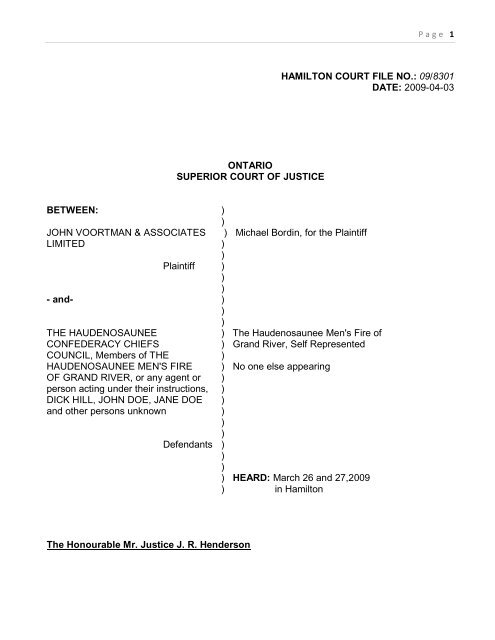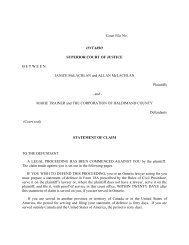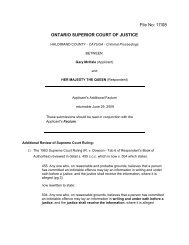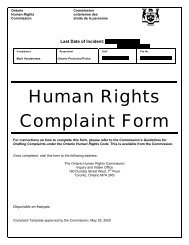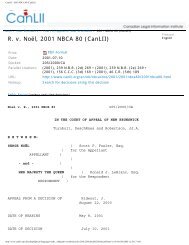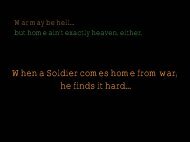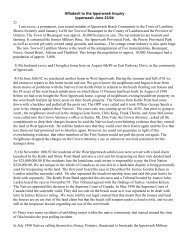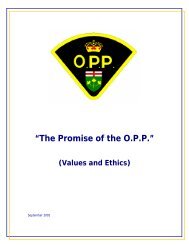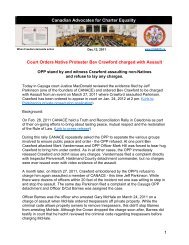Reasons for Decision - Caledonia Wake Up Call
Reasons for Decision - Caledonia Wake Up Call
Reasons for Decision - Caledonia Wake Up Call
You also want an ePaper? Increase the reach of your titles
YUMPU automatically turns print PDFs into web optimized ePapers that Google loves.
Page 1HAMILTON COURT FILE NO.: 09/8301DATE: 2009-04-03ONTARIOSUPERIOR COURT OF JUSTICEBETWEEN: ))JOHN VOORTMAN & ASSOCIATES ) Michael Bordin, <strong>for</strong> the PlaintiffLIMITED ))Plaintiff )))- and- )))THE HAUDENOSAUNEE) The Haudenosaunee Men's Fire ofCONFEDERACY CHIEFS) Grand River, Self RepresentedCOUNCIL, Members of THE )HAUDENOSAUNEE MEN'S FIRE ) No one else appearingOF GRAND RIVER, or any agent or )person acting under their instructions, )DICK HILL, JOHN DOE, JANE DOE )and other persons unknown )))Defendants )))) HEARD: March 26 and 27,2009) in HamiltonThe Honourable Mr. Justice J. R. Henderson
Page 2REASONS FOR DECISION ON MOTIONINTRODUCTION[1] The plaintiff, John Voortman & Associates Limited, (hereinafter called "Voortman") brings thismotion <strong>for</strong> an interlocutory injunction restraining the defendants from entering onto the property knownmunicipally as 68A Main Street North, Hagersville, Ontario (hereinafter called "the property"), andrestraining the defendants from interfering with Voortman' s construction of a residential subdivision onthe property.[2] The Haudenosaunee Confederacy Chiefs Council (hereinafter called the "HCCC") did notappear on this motion. However, several members of the Haudenosaunee Men's Fire of Grand Riverappeared in court and spoke against Voortman's motion. In this decision I will refer to the members ofthe Haudenosaunee Men's Fire as the "HMF".[3] The Haudenosaunee are aboriginal people whose ancestors were members of the five originalnations of the Iroquois Confederacy. They are part of what is now commonly called the Six Nations.The HCCC are the traditional leaders of the Haudenosaunee people, and the HMF is a groupcomposed of some of the Haudenosaunee people.[4] Voortman submits that the plaintiff corporation is the registered owner of the property and assuch is entitled to exercise the rights of a property owner. Those rights include the development andconstruction of a subdivision.[5] The HMF correctly state that the property is part of the Haldimand Tract, which is an area ofland that is the subject of an ongoing unresolved dispute between the Six Nations and the federal andprovincial governments.[6] The HMF do not deny that they have attended on the property and have obstructed theconstruction of the subdivision, but state they have done so because they have an interest in theproperty and are bound by aboriginal laws to protect that land.THE BACKGROUND FACTS[7] I find that Voortman purchased the property on November 30,2001 <strong>for</strong> value and consequentlybecame the registered owner on title in the Haldimand County Land Registry Office. Subsequently, theland registration system was converted to the land titles system. Since that time Voortman has beenshown as the owner of the property under the land titles system.
Page 3[8] Voortman can trace its title to the property back to the Crown Patents of 1849 and 1850. Also,there are sworn declarations that establish quiet undisturbed possession of the property by theregistered owners back to 1916.[9] The property consists of six acres of raw land upon which Voortman intends to build asubdivision of 46 townhomes. I note that the property is in an area of Hagersville that is bordered on allsides by a mixture of residential, commercial, and community buildings. There are no woodlands,rivers, streams, or bodies of water on the property.[10] Voortman submitted a draft plan of subdivision to Haldimand County in the spring of 2008, andthe plan of subdivision was approved and registered on title on April 4, 2008. Voortman did not havenotice of any aboriginal claim prior to the registration of the plan of subdivision, but the County Plannerhad clearly circulated the plan of subdivision to all interested parties, including representatives of theSix Nations Elected Council (hereinafter called the "Six Nations Council").[11] I note that the Six Nations Council is a recognized body that deals with administrative matterson behalf of the Six Nations people. However, the Six Nations Confederacy Chiefs (hereinafter calledthe "Six Nations Chiefs") are recognized as the hereditary leaders of the Six Nations people.[12] Thereafter, a site plan agreement was entered into between Voortman and Haldimand Countyon September 11,2008, and that site plan agreement was registered on title on October 14, 2008.[13] Chief William Montour of the Six Nations Council wrote to the Senior Planner at HaldimandCounty on June 6, 2008, and said that the property was part of the lands in the Hamilton-Port DoverPlank Road land claim. That land claim is one of many that the Six Nations Council has filed regardinglands in the Haldimand Tract.[14] In his letter Chief Montour wrote: "Six Nations' position still stands that these lands should notbe subject to any development until Six Nations' land claims are settled with the provincial and federalgovernments". A copy of that letter was sent to Voortman,and constituted Voortman's first notice of anypotential aboriginal objection to the subdivision.[15] Prior to receiving this letter and prior to circulating the plan of subdivision, John Voortman Sr.,an officer of Voortman, had in fact spoken with Chief William Montour about this subdivision, and hehad received some oral assurances from Chief Montour that the Six Nations Council would besupportive of this subdivision. After his receipt of the letter Mr Voortman tried to contact Chief Montour,but his calls were not returned.
Page 4[16] In early October 2008 Voortman arranged <strong>for</strong> the clearing and the levelling of the property <strong>for</strong>the purpose of commencing the construction. Voortman hired Almas Construction to do the levellingand clearing.[17] On October 9, 2008 a group of approximately 8 to 10 aboriginal persons attended at theproperty to protest the construction. I accept that the aboriginal persons occupied the property and hadthe collective intention to interfere with and prevent the construction on the site. Voortman was advisedthat the property was aboriginal land and that the aboriginal group would come back to the property dayafter day until construction was stopped.[18] On that date O.P.P. officers attended at the construction site, but refused to remove theaboriginal persons from the site. One of the O.P.P. officers advised John Voortman Jr. that the O.P.P.was there to keep the peace, but they would not act to remove any protesters unless a court injunctionwas obtained.[19] As a result of the events of October 9,2008, Almas Construction was <strong>for</strong>ced to stop its work andthereafter refused to carry on any further work on the property. There<strong>for</strong>e, no work was done on theproperty between approximately October 10,2008 and December 7,2008.[20] During that time John Voortman Sr. contacted several leaders in the aboriginal community <strong>for</strong>assistance with respect to this dispute. Also on November 25,2008, Voortman's lawyers wrote to ChiefMontour of the Six Nations Council and Chief MacNaughton of the Six Nations Chiefs, requesting thatthey contact Voortman's lawyers in order to resolve the issue.[21] By letter dated December 4,2008, Lonny Bomberry wrote back to Voortman's lawyers on behalfof the Six Nations Council. Mr. Bomberry acknowledged that there was a presumption of the legality ofthe Crown Patents upon which Voortman relied to establish its title, but also stated that it was theposition of the Six Nations that these lands had never been lawfully surrendered. The letter confirmedthat there was an ongoing lawsuit with respect to the Haldimand Tract lands, but the lawsuit was beingheld in abeyance pending negotiations with the federal and provincial governments. The negotiationswere being led by the Six Nations Chiefs with the assistance of the Six Nations Council.[22] This letter also stated that the Six Nations Council was aware that the HMF and another groupcalled the Haudenosaunee Development Institute (hereinafter called the "HDI") were showing up atconstruction sites to stop developments in Brant and Haldimand Counties, but that the Six NationsCouncil did not condone the conduct of the HDI or the HMF or their supporters.[23] As a result, on December 7,2008 Almas Construction went back to the job site and commencedwork clearing the property.
Page 5[24] Then, on December 18,2008 there was another incident on the property. On that dateapproximately 8 to 10 aboriginal persons again occupied the property and shut down work on theproperty. Again O.P.P. officers attended at the site but would not remove the aboriginal persons.[25] John Voortman Sr. attended at the property and spoke with Dick Hill, one of the aboriginalpersons, who in<strong>for</strong>med Mr. Voortman that he represented the HMF. He said that the aboriginal peoplewould not allow construction to occur on the property and that he and other aboriginal people intendedto occupy the property to prevent construction. He said that he and the others would do whatever it tookto prevent the development; that they would block Voortman' s machinery; that they would jump on themachinery and remove the keys by <strong>for</strong>ce if necessary.[26] Dick Hill demanded that Voortman meet with the HMF about this matter. Consequently, onDecember 21, 2008, John Voortman Sr. and his wife attended a meeting with members of the HMF.[27] At the meeting of December 21,2008, Mr. Voortman and his wife attended with approximately14 men who were apparently members of the HMF. I accept the evidence that these 14 men did notclearly identify who they were, or who they represented, except that they used the nameHaudenosaunee and claimed to represent the interests of Haudenosaunee people.[28] At the meeting, Mr. Voortman attempted to explain how he had obtained title to the property andhow he intended to develop it. I accept his evidence that he was told by one of the apparent leaders ofthe group that he had to give the property back. He was in<strong>for</strong>med that he should convey the propertyback to the Haudenosaunee people and then take a lease of the land in perpetuity.[29] When Mr. Voortman raised the issue of a potential injunction he was in<strong>for</strong>med that the HMFwould not abide by any injunction. He was told that the HMF would fight <strong>for</strong> the land and were preparedto die <strong>for</strong> it. He was also the subject of an angry racial attack against "white people".[30] The net result of the meeting was that Mr. Voortman came away with the clear understandingthat the HMF and their supporters would occupy the property and obstruct construction on the propertyat any cost. I accept that he felt very intimidated and frustrated.[31] The construction work was stopped on December 18,2008 and did not resume until after thiscourt action was commenced and a temporary order was made on March 4,2009 that permitted limitedwork to be done on the property.[32] At the present time Mr. Voortman estimates that the plaintiff corporation has spentapproximately $539,000 in purchasing and developing the property. Moreover, Voortman has enteredinto several binding contracts <strong>for</strong> subcontractors to do work on the property, and Voortman has enteredinto the site plan agreement with the County to build town homes on the property.
Page 6THE LAW REGARDING INJUNCTIONS[33] The traditional test to be applied in considering whether an interlocutory injunction will begranted is the three-step test set out by the Supreme Court of Canada in the case of RJR-MacDonaldInc. v. Canada (Attorney General), [1994] 1 S.C.R. 311. The three criteria in this test can be set out byway of the following three questions:1. Is there a serious question to be tried?2. If the injunction is not granted will the plaintiff suffer irreparable harm?3. Which party will suffer the greater harm if the injunction is granted or refused? This iscalled the balance of convenience test.[34] Where there has been interference with property rights it has been held that the traditional testshould be modified so that the issue of whether there is a serious question to be tried will be stronglyemphasized, almost to the exclusion of the other two issues.[35] I reviewed the law in support of that proposition in an earlier case reported as City of Hamilton v.Loucks (2003), 232 D.L.R. (4th) 362, and I adopt my reasoning in that case <strong>for</strong> the purposes of thisdecision.[36] Also, in support of the modification of the traditional test I refer to an excerpt from Injunctionsand Specific Per<strong>for</strong>mance, Loose Leaf Edition, at paragraph 4.610 wherein the author of the book,Justice Robert Sharpe wrote:"Under our system of law, property rights are sacrosanct. For that reason, the rules thatgenerally apply to injunctions do not always apply in cases such as this. The balance ofconvenience and other matters may have to take second place to the sancrosanctity [sic] ofproperty rights in matters of trespass."[37] Justice Sharpe also wrote at paragraph 4.10 of his book:"Where property rights are concerned, it is almost that damages are presumed inadequateand an injunction to restrain continuation of the wrong is the usual remedy."SERIOUS ISSUE TO BE TRIED[38] Voortman's claim is quite simple. Voortman claims to be the owner of the property by way of achain of title going back to the Crown Patents. Voortman is entitled to rely on that chain of title.There<strong>for</strong>e Voortman has the right to exclude others from the property, and has the right to build on the
Page 7property, provided it has complied with all regulatory laws. If another party interferes with Voortman'sproperty rights, Voortman is entitled to a court remedy. Thus, Voortman claims to have a strong case<strong>for</strong> relief today.[39] The HMF on the other hand also act as if they have a proprietary interest in the land. They claimto have a right to occupy the land and control the activity on the land. In effect they claim to have a rightto regulate development on the property in the Haldimand Tract on such terms as they deem to beappropriate.[40] If Voortman is the lawful owner, the actions of the members of the HMF amount to trespass,nuisance, extortion, intimidation and inducing breach of contract. There<strong>for</strong>e, if Voortman can establish astrong case to support its submission that it is the lawful owner of the property, then I accept that thereis a serious issue to be tried, and prima facie an injunction should issue.[ 41] The presentation by the HMF at this motion was somewhat unusual in that the representativesof the HMF stated that they did not wish to submit to the court process, but wished to deliver amessage to the court. I permitted them to deliver their message and gave them some leeway as to theway in which the message was delivered. Having done that, I feel as if I received the message that theywished to convey.[42] The HMF message dealt with aboriginal laws and beliefs. I accept that the message wasdelivered in good faith and in the spirit of resolution. However, I need to adapt that message andconsider it in the context of the laws of this Province. It is important, <strong>for</strong> reasons that I will set out later inthis decision, that one set of laws apply to all of the people in this Province.[43] From the presentation by the HMF, I discern that there are three issues that the HMF say affectthe strength of Voortman's case. They say first, that the Six Nations people have a legal claim to theproperty; second, that Voortman does not have legal title to the property; and third, that the court doesnot have jurisdiction to make the requested order because the Crown has not consulted with theaboriginal people about this property. I will deal with each of these issues in order.I - THE PROPERTY CLAIM OF THE SIX NATIONS[ 44] The HMF take the position that their actions are justified because the aboriginal people have alegal claim to this land. It is acknowledged that the property lies within the Haldimand Tract; an area ofland encompassing six miles on either side of the Grand River. The Haldimand Tract was the subject ofthe Haldimand Proclamation of 1784, and the subject of Simcoe's Patent of 1793.[45] It has been submitted in the past that the Haldimand Proclamation and Simcoe's Patentcombined to grant title to the Haldimand Tract to the Six Nations people. That position was taken by
Page 8Chief J oseph Brant and has been maintained by many of the hereditary chiefs thereafter. This issuewas considered by the courts in 1974 in the case of Isaac v. Davey, 5 O.R. (2d) 610. In summary, theOntario Court of Appeal held in Isaac that the combined effect of the Haldimand Proclamation andSimcoe's Patent did not vest title to the lands in the Six Nations people.[46] In Isaac, after a thorough review of the history, the court stated, using the language of the day,at paras. 31 and 32 that the intention of the Proclamation and the Patent was "to confer upon the loyalsubjects of the Crown within the Six Nations Confederacy ... the same rights as were enjoyed by thoseIndians who had always been there". They did not "create a unique interest" in the Haldimand Tractwhich no other native people enjoyed.[47] The court in Isaac wrote at paragraph 30:"For the purposes of this case, it is sufficient to say that Indian title in Ontario has been 'apersonal and usufructuary right, dependent on the good will of the Sovereign'. Indian landswere reserved <strong>for</strong> the use of the Indians, as their hunting grounds, under the Sovereign'sprotection and dominion. The Crown at all times held a substantial and paramount estateunderlying the Indian title. The Crown's interest became absolute whenever the Indian titlewas surrendered or otherwise extinguished."[48] The Six Nations Council have filed several claims regarding different parts of the HaldimandTract, including a claim filed in 1987 regarding the lands known as the Hamilton-Port Dover Plank Roadlands. Subsequently, in 1995, a legal action was commenced by the Six Nations Council against thefederal and provincial governments regarding the entire Haldimand Tract. The Six Nations Chiefs andthe Six Nations Council are both involved in negotiations to resolve thisaction.[49] The position of the Six Nations Council is set out in their letter to Voortman's counsel.Essentially, the Six Nations Council takes the position that the aboriginal interest in the land in theHamilton-Port Dover Plank Road land claim was never lawfully surrendered to the Crown. But, in thelegal action there is no claim <strong>for</strong> an interest in the land. That is, the Six Nations Council do not make alegal claim <strong>for</strong> possession of or return of the land. Rather, the 1995 legal action claims an accounting<strong>for</strong> all revenues that the Six Nations people should have received from the land.[50] In summary, the Ontario Court of Appeal has found that there has been no conveyance of titleto the Six Nations people, and the two recognized governing bodies of the aboriginal people, namelythe Six Nations Council and the Six Nations Chiefs, have not made any claim <strong>for</strong> title to or possessionof the property.
Page 9[51] Moreover, even if the HMF have the authority to speak on behalf of the Six Nations people, Inote that there is no claim made by the HMF in this action or in any other action <strong>for</strong> the possession of orreturn of this property. The only request that the HMF have made with respect to the return of the landsis the demand that was made of Mr. Voortman Sr. at the meeting of December 21, 2008.[52] There<strong>for</strong>e, I find that there is no merit to the suggestion that the Six Nations people have a rightto ownership of the property. I find that if there is an aboriginal claim it is <strong>for</strong> compensation <strong>for</strong> the lossof the usufructuary right regarding the property, not <strong>for</strong> title to the land.II - THE PROPERTY CLAIM OF VOORTMAN[53] The validity of a Crown Patent was raised in the case of The Chippewas of Sarnia Band v.Canada, 51 O.R. (3d) 641. In that case at para. 24 the Ontario Court of Appeal held that a CrownPatent was valid on its face and continued to have legal effect unless and until a court decides toexercise its discretion to set it aside.[54] In that case, the court found that the aboriginal lands in question had never been surrendered,and there<strong>for</strong>e the validity of the Crown Patent, known as the Cameron Patent, was called into question.The court had to consider a potential remedy <strong>for</strong> the Chippewas. At para. 243 the court wrote:"In particular, the issue was whether it is appropriate, in deciding whether or not to accordthe Chippewas a remedy, <strong>for</strong> the court to consider that no claim was asserted <strong>for</strong> 150 years,and that innocent third parties may have relied on the apparent validity of the Cameronpatent."[55] The court decided that because of the delay of 150 years in asserting the claim, combined withthe reliance on the Patent by the registered owners, the court should use its discretion to refuse aremedy in the <strong>for</strong>m of a return of or possession of the land. However, the court noted that theChippewas still had a claim against the Crown <strong>for</strong> damages. See paragraphs 246, 248, 302, and 310 ofthe Chippewas case.[56] In the present case Voortman can trace its title back to the Crown Patents, and there<strong>for</strong>e,pursuant to the Chippewas case, Voortman' s title is presumed to be valid. That presumption isacknowledged by the Six Nations Council in its letter to Voortman's lawyers. Moreover, even if thesurrender of the Hamilton-Port Dover Plank Road land in this case is found to be invalid, given thedecision in the Chippewas case, it is very unlikely that the court would set aside the Crown Patents.[57] There<strong>for</strong>e, I find that Voortman has a strong case to show that it is the legal owner of theproperty, and that Voortman is entitled to exercise its rights as the property owner. The arguments to
Page 10the contrary are weak, and even if successful would not result in any change in the registeredownership of the property.III - THE DUTY TO CONSULT[58] The HMF take the position that this court has no jurisdiction to make the requested orderbecause the Crown has not fulfilled its duty to consult regarding this dispute.[59] The obligation of the Crown to consult where a claim is made with respect to aboriginal rightswas discussed in the case of Haida Nation v. British Columbia (Minister of Forests), 2004 S.C.C.73. Inthat case the Supreme Court of Canada held at paras. 32 to 35 that a duty to consult and possiblyaccommodate arises when the Crown has knowledge, real or constructive, of the potential existence ofthe aboriginal right or title and contemplates conduct that might adversely affect it.[60] The court also wrote at paras. 39 to 51 that the duty to consult was contextual in nature, andvaried according to the circumstances of each specific case. In particular, at para. 39 of the HaidaNation case the court wrote:"The content of the duty to consult and accommodate varies with the circumstances.Precisely what duties arise in different situations will be defined as the case law in thisemerging area develops. In general terms, however, it may be asserted that the scope ofthe duty is proportionate to a preliminary assessment of the strength of the case supportingthe existence of the right or title, and to the seriousness of I the potentially adverse effectupon the right or title claimed."[61] The court also further defined the nature of the duty to consult at paras. 43 and 44 as follows:"Against this background, I turn to the kind of duties that may arise in different situations. Inthis respect, the concept of a spectrum may be helpful ... At one end of the spectrum liecases where the claim to title is weak, the Aboriginal right limited, or the potential <strong>for</strong>infringement minor. In such cases, the only duty on the Crown may be to give notice,disclose in<strong>for</strong>mation, and discuss any issues raised in response to the notice ...At the other end of the spectrum lie cases where a strong prima facie case <strong>for</strong> the claim isestablished, the right and potential infringement is of high significance to the Aboriginalpeoples, and the risk of non-compensable damage is high. In such cases deep consultation,aimed at finding a satisfactory interim solution, may be required." ...[62] Moreover, the Supreme Court of Canada held at paras. 52 to 56 that the duty to consult was theduty of the Crown, not the duty of a third party land owner.
Page 11[63] The Ontario Court of Appeal appeared to push this duty further in the case of FrontenacVentures Corp. v. Ardoch Algonquin First Nation (2008), 91 O.R. (3d) 1, at para. 48 where the courtwrote:"Where a requested injunction is intended to create 'a protest-free zone' <strong>for</strong> contentiousprivate activity that affects asserted aboriginal or treaty rights, the court must be very carefulto ensure that, in the context of the dispute be<strong>for</strong>e it, the Crown has fully and faithfullydischarged its duty to consult with the affected First Nations ... The court must further besatisfied that every ef<strong>for</strong>t has been exhausted to obtain a negotiated or legislated solution tothe dispute be<strong>for</strong>e it..."[64] I agree with Voortman' s counsel that the Frontenac case cannot be interpreted to mean that inevery dispute between a private land owner and an aboriginal group the Crown must engage inexhaustive consultations. The Ontario Court of Appeal could not have meant that every private landowner in the Haldimand Tract could be subjected to an aboriginal occupation of his/her lands,and if so, then the Crown must consult about every parcel of private land in the Haldimand Tract.[65] For that reason, I must use the contextual approach set out in the Haida Nation case to definethe nature of the duty to consult in the present case and determine where in the spectrum the Crown'sduty to consult lies.[66] I have taken into account the fact that there is a presumption based on the Crown Patents thatVoortman is the registered owner of the property, and that Voortman prima facie is entitled to exercisethe rights of a property owner. I have also considered the fact that there has been no aboriginal claim tothe land asserted <strong>for</strong> more than 150 years and that there is documentation to establish quietundisturbed possession back to at least 1916. I have also taken into account the fact that therecognized aboriginal leaders, the Six Nations Council and the Six Nations Chiefs, have not asserted aclaim to ownership of the land, and the HMF have not made a legal claim <strong>for</strong> ownership of the land.Using the language of the Haida Nation case, I find that the aboriginal claim is weak and the privatelandowner's case is strong.[67] I have also taken into account the fact that an injunction would not significantly affect anyaboriginal claim <strong>for</strong> damages. The remedy of the Six Nations people seems to be a claim <strong>for</strong> damagesagainst the Crown, and that remedy would not be affected by an injunction.[68] Given all of these considerations, I find that the Crown's duty to consult in this case is at the lowend of the spectrum. I find that the Crown had a duty to notify the Six Nations Council of Voortman'sintention to develop the property, and to listen to, but not necessarily agree with, any concerns raisedby the Six Nations Council in response.
Page 12[69] There<strong>for</strong>e, on the facts of this case I must find that the Crown has complied with its duty toconsult. Specifically, the Six Nations Council were provided with the draft plan of subdivision <strong>for</strong> theircomments. No response to the draft plan of subdivision was received prior to its approval andregistration.[70] Later, after Voortman became aware of the concerns of the Six Nations Council and the HMF,Mr. Voortman Sr. responded by contacting several aboriginal leaders and attempting to contact ChiefMontour. Moreover, Voortman's lawyers wrote to the Six Nations Chiefs and the Six Nations Council,and received a response that the Six Nations Council was not supporting the occupation of Voortman'sproperty by the HMF or its supporters.[71] Furthermore, I find that there were, and continue to be, ongoing consultations regarding theHaldimand Tract and those consultations in part deal with the Voortman property. Both the Six NationsChiefs and Council are participating in those consultations. That alone constitutes good faithconsultation by both sides in this very complex dispute.[72] That brings me to the question of whether the Crown is compelled to consult with the HMFdirectly in addition to consulting with the Six Nations Chiefs and Council. Clearly, HMF takes theposition that the Crown must negotiate with them about any development on the property. However, Ihave not received any cogent explanation of the relationship between the HMF and the Six NationsChiefs or Council.[73] In my view the HMF is not well defined and its authority to represent aboriginal people is notwell established. There are two entities that are recognized as having some authority to speak <strong>for</strong> theSix Nations; namely the Six Nations Council and the Six Nations Chiefs. The Crown has consulted withboth, and in my view, has no duty to also consult with yet another aboriginal group.[74] That being said, I note that Voortman did participate in one meeting with 14 men who apparentlywere members of the HMF, but in hindsight that meeting was fruitless. There is no further obligation onVoortman or on the Crown to consult directly with the HMF.[75] For all of these reasons I find that in this case the Crown has fulfilled its duty to consult. I findthat the suggestion by the HMF that the court cannot grant an injunction because the Crown has failedto consult with the aboriginal people has no merit.IV - CONCLUSION REGARDING SERIOUS ISSUE TO BE TRIED[76] I now wish to summarize my findings with respect to whether there is a serious issue to be tried.I accept that Voortman is the registered owner of the property and there<strong>for</strong>e is entitled to exercise its
Page 13rights as owner. I accept that the Six Nations people have an ongoing claim regarding these lands, butthat claim is not <strong>for</strong> title to or possession of the lands; rather it is <strong>for</strong> damages.[77] I find that the ongoing claim was commenced by the Six Nations Council, and that there areongoing negotiations regarding this claim. These negotiations are being pursued by the Six NationsCouncil and the Six Nations Chiefs. There is no independent claim of the HMF.[78] I also find that the actions of the HMF amount to both criminal and civil misconduct. Theiractions have interfered with the property rights of Voortman and can be characterized as nuisance,trespass, extortion, intimidation, and inducing breach of contract.[79] There<strong>for</strong>e, I find that Voortman has established that there is a serious question to be tried andVoortman has done so to standard of establishing a strong prima facie case.IRREPARABLE HARM AND BALANCE OF CONVENIENCE[80] Even though the issues of irreparable harm and balance of convenience are not significantfactors in a case like this, I still find that both factors favour Voortman.[81] Regarding irreparable harm, I find that if the injunction is not granted it is probable thatVoortman would suffer irreparable damage to its reputation as a builder; that Voortman's ability toconstruct a townhome development and sell the townhomes would be diminished; that Voortman' sinvestment in the property would be depleted or extinguished; and that Voortman would probably be thesubject of legal actions <strong>for</strong> breach of already existing contracts. Voortman could not be adequatelycompensated <strong>for</strong> these losses by monetary damages alone.[82] Regarding the balance of convenience, Voortman has a strong case as the registered landowner and will clearly suffer damages if the injunction is not granted. On the other hand, the case of theHMF is limited. The claim of the Six Nations is only with respect to damages, not with respect to theland. The appropriate remedy <strong>for</strong> the Six Nations people is to make a claim <strong>for</strong> damages against theCrown, and that has already been done. Their remedy will not be lost if an injunction were granted.[83] There<strong>for</strong>e, I find that all three of the criteria set out in the RJR MacDonald case favour Voortmanin this case.THE RULE OF LAW[84] Be<strong>for</strong>e I conclude I would like to emphasize the rule of law. All people in Canada are governedby the rule of law as confirmed in the preamble to the Charter of Rights and Freedoms. That is, allpeople in Canada are required to obey the law. As a corollary, all people in Canada are entitled to know
Page 14that every other person in Canada will be required to obey the law. If any person in Canada does notobey the law, the courts will en<strong>for</strong>ce the law. In that way the public has some assurance that they canlive in peace without fear of those who might choose to disobey the law.[85] In the present case the representatives of the HMF delivered a message to this court that theydid not accept the court process. Moreover, there was a veiled threat that if an injunction were to issuethe HMF would have no choice but to continue their tactics of intimidation and criminal and civildisobedience. That threat does not alter or affect my decision today.[86] The HMF clearly have a choice. An injunction will be issued today. The HMF may choose ingood faith to abide by the injunction, live within the criminal and civil law, participate in peacefuldemonstrations, and pursue whatever claim they believe they have through their own negotiationsand/or court actions. They are not compelled, as was suggested, to disobey the injunction and engagein further criminal and civil misconduct.[87] The rule of law means that the HMF will be required to obey any court order, just as any personin Canada would be required to obey a court order. The assertion of an aboriginal right does not permitany person, aboriginal or otherwise, to break the law.CONCLUSION[88] For all of the a<strong>for</strong>ementioned reasons I find that Voortman is entitled to an Order <strong>for</strong> aninterlocutory injunction restraining the defendants from entering onto the property and from obstructingVoortman's development of the property.[89] I also declare that Voortman has title to and is the owner of the property, and as such is entitledto exclusive possession of the property. I make this finding so that no other group can come <strong>for</strong>ward tooccupy the property as the putative land owner.[90] This Order will be en<strong>for</strong>ced by the Sheriff of Haldimand County with the assistance of the O.P.P.I also order that Voortman and its designates may use reasonable <strong>for</strong>ce to prevent any person fromtrespassing upon the property, and to remove any trespasser from the property in accordance with theprovisions of the Criminal Code of Canada.[91] There<strong>for</strong>e, an Order <strong>for</strong> an interlocutory injunction will go in accordance with paragraphs three(a), (b) and (c), four, five, six (a), (b) and (c), seven and eight of the Notice of Motion.Henderson, J.Released: April 3, 2009


